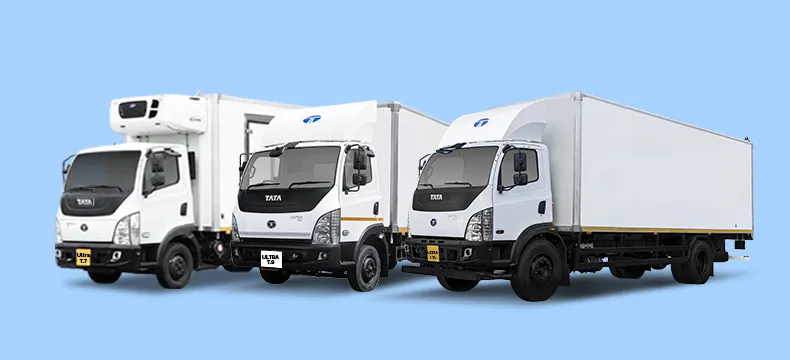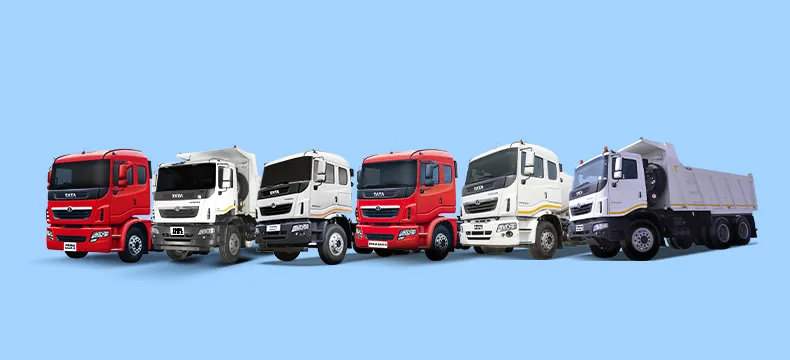12 Dec 2025

Box Trucks: Definition and Types
- Tata Motors
- 16 Oct 2025
- COMMERCIAL VEHICLE
Introduction
Across the Middle East, the logistics and delivery ecosystem is transforming. As businesses and urban infrastructure expand, the need for reliable and efficient transportation solutions is more crucial than ever.
Here is where a box truck comes into play. Currently, box trucks are growing pillars in the transportation industry. The surge in demand echoes a broader shift toward sustainable and fuel-efficient logistics. At Tata Motors, we have expanded our global footprint by responding to these exact demands.
In this guide, we'll walk you through what a box truck is, the types of box trucks, standard box truck sizes and how to choose the right one for your needs.
What are Box Trucks?
A box truck is also referred to as a cube van, straight truck or rolling toaster. When it comes to understanding the meaning of a box truck, it is defined by its signature cuboid-shaped cargo area attached to a chassis cab.
The box truck definition stems from its design: a rectangular "box" for transporting packaged, palletised or boxed goods securely. This shape isn't just aesthetic; it optimises space usage while protecting cargo from weather and damage.
The closed body and ease of manoeuvrability of a box truck have made them valuable across commercial sectors. In Middle Eastern markets, they are crucial for navigating city streets, industrial zones, and remote delivery points.
Types of Box Trucks: What Can They Transport?
Here are some of the most common Box truck types based on their applications across industries:
-
Retail & Distribution Box Trucks
Used for delivering merchandise like high-value electronics and consumer goods to retail outlets across the GCC. These trucks often feature enhanced security for valuable cargo.
-
Furniture & Appliance Box Trucks
Designed for the safe and efficient transport of bulky household items like sofas, refrigerators, and washing machines, particularly in urban centers like Riyadh or Dubai where careful handling and manoeuvrability are key.
-
Refrigerated (Reefer) Box Trucks
Essential for the food and beverage industry, these trucks are equipped to handle temperature-sensitive goods, from fresh produce to frozen and ambient food items, ensuring safe delivery to hypermarkets, restaurants, and hotels.
-
Mobile Business Box Trucks
Converted into mobile enterprises, these trucks serve as food trucks, mobile boutiques or service units at events and markets, offering entrepreneurs a versatile business platform on wheels.
This adaptability positions the box truck as one of the most multi-functional assets in modern logistics.
Variants of Box Trucks offered by Tata Motors:
In dry and non-perishable freight movement, particularly within the Middle East's harsh climate, reliability is essential. Here's how Tata Motors is delivering this with well-engineered options:
-
Tata Ultra T.7
The Ultra T.7 features enhanced safety with full-air dual-circuit S-cam brakes, ABS and ESP. Its 3.3L engine outputs 155 PS and 450 Nm torque, complemented by an ergonomic cabin with HVAC ventilation. This is important for operations in high-temperature environments.
-
Tata Ultra T.9
For businesses that require stronger performance, the Ultra T.9 is a dependable option. With features like parabolic front springs and rear semi-elliptical leaf springs, it delivers both durability and comfort. Its 3.3L engine and 450 Nm torque output make it suitable for larger payloads in longer-distance delivery.
-
Tata Ultra T.16
This model redefines productivity for long-haul needs. With 180 Ps and 590 Nm of torque, it's made for heavier-duty operations. It ensures enhanced safety and easy handling through hydraulic power steering and an anti-lock braking system (ABS). Hence, it's well-suited for both regional and intercity logistics.
Each type of box truck at Tata Motors is crafted with the operational challenges of Middle Eastern businesses in mind.
Why Use a Box Truck?
The cargo box truck continues to gain popularity in urban and regional logistics for several reasons:
-
Accessibility:
Easily navigates congested city roads where larger vehicles can't.
-
Versatility:
From electronics to perishables, it accommodates a wide range of cargo types.
-
Simplified Maintenance:
Fewer mechanical complexities result in lower upkeep costs.
-
Efficient Operations:
Hydraulic lift gates and rear loading ease operations. This is important in markets with tight delivery schedules.
-
Regulatory Compliance:
Typically meets urban road and weight regulations, reducing clearance-related disruptions.
Conclusion
The box truck strikes a balance between volume, agility and flexibility. This makes it the go-to choice for Middle Eastern logistics players. Whether you're delivering across Dubai's commercial districts or managing cargo routes through Riyadh's outskirts, there's a box truck configuration to meet your business needs.
Your success doesn't just depend on how you use a truck; it also depends on the type of truck you choose. Hence, choose Tata Motors as we are engineered for performance and built for progress.
FAQs
What is the difference between a box truck and a straight truck?
While often used interchangeably, a box truck typically refers to a straight truck where the cargo area and cab are on the same chassis.
What are the different weight classes of box trucks?
They generally fall into three categories: light, medium, and heavy-duty, depending on the Gross Vehicle Weight Rating (GVWR).
What industries benefit the most from using box trucks?
Retail, logistics, construction, food delivery and mobile services frequently rely on box trucks for their secure and adaptable cargo capabilities.
How do box trucks compare to semi-trucks in terms of cost and usability?
Box trucks are more affordable to purchase, maintain and operate. They are better suited for shorter routes and city deliveries than semi-trailers.
- Tags





















